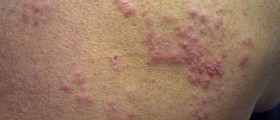
Shingles (herpes zoster) is a painful and blistering skin rash that affects individuals who have once had chickenpox. The virus that normally causes chickenpox never leaves the body of the affected individual and stays dormant in spinal nerve roots. After many years in case the immune system becomes weak, the virus reactivates and spreads along nerves and finally causes rather painful blistering of the skin.
Shingles is mostly reported in elderly individuals and is a common medical condition affecting immunocompromised patients. The disease develops only on one side of the body. The affected skin is covers with blisters of different size and pain is actually a consequence of damage to the nerve innervating the affected part of the skin. The virus uses the nerve to gets to the skin.
In the majority of patients rash lasts 7-10 days and heals within additional 2-4 weeks. Pain is the most severe characteristic of shingles and is alleviated only with potent pain killers. Most people overcome disease successfully while some may end up with postherpetic neuralgia, a complication that may be permanent.
Treatment for Shingles
Rash in patients suffering from shingles must be kept clean and dry. With proper care of the affected skin, one may avoid secondary skin infections. Because the skin is too sensitive patients are supposed to wear loose-fitting clothing. Itching may be relieved with Calamine lotions and antihistamine drugs.
As far as pain is concerned, depending on its intensity patients are prescribed different pain relieving medications. Mild pain can be brought under control with paracetamol and NSAIDs. Normally, these drugs are not prescribe to patients who have stomach or kidney problems (e.g. a peptic ulcer), liver problems, are suffering from asthma and are pregnant/breastfeeding.
Opioids are quite efficient against pain. Codeine is one of the most commonly prescribed drugs for people suffering from shingles.
Severe pain may be dealt with some antidepressants. These drugs are usually prescribed to patients who have developed postherpetic neuralgia. Some of them are amitriptyline, imipramine and nortriptyline. In case of any side effects doctors may adjust the dose or replace the drug with another antidepressant.
Anticonvulsants are under normal circumstances prescribed to patients suffering from epilepsy. They are, however, also highly efficient in managing pain patients suffering from shingles face with. Gabapentin is frequently used antiepileptic drug in case of shingles.
Finally, along with pain killers, patients may be additionally administered antiviral drugs such as acyclovir, Valacyclovir and famciclovir. They reduce the severity of rash, accelerate healing and may sometimes prevent complications.
Prevention of Shingles
It is hard to prevent shingles from occurring, sometimes even impossible. The explanation is simple. We do not known when our immune system will be weak enough and what trigger will be sufficient enough to reactivate the virus. But, if one manages to stay stress-free and eat healthy, the chance of shingles may reduce. Once the experts identify triggers of shingles, prevention may be possible.
There is a vaccine called Zostavax, capable of preventing shingles in individuals over the age of 60. The vaccine is most efficient in people between the age of 60 and 69, while its efficacy declines once the person enters seventh decade of his/her life. This vaccine is never administered in people who have already had viral reactivation.

















Your thoughts on this
Loading...